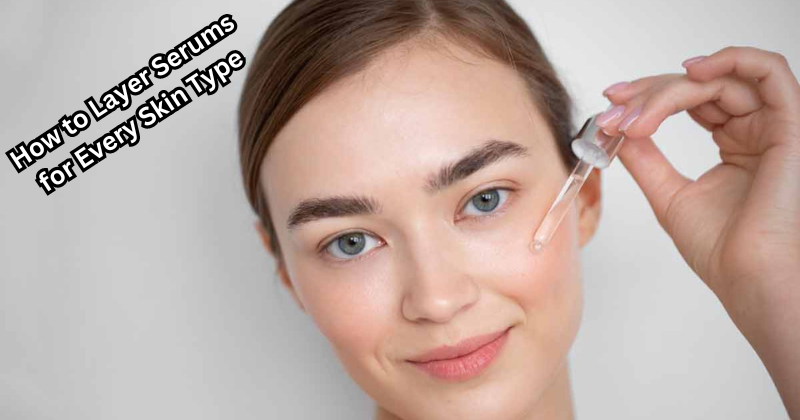Wondering how to layer serums in your skincare routine? Proper layering maximizes the benefits of each serum, addressing multiple skin concerns effectively.
This guide will help you with a step-by-step approach, ensuring you get the most out of your serums without overwhelming your skin.
Key Takeaways
- Layering serums properly enhances the effectiveness of a skincare routine by allowing each product to penetrate the skin and deliver its maximum benefits.
- Applying serums from lightest to heaviest ensures optimal absorption of active ingredients, preventing blockage by thicker products.
- Limiting the number of serums to a maximum of three can prevent skin irritation and improve overall efficacy, focusing on targeted skin concerns without overwhelming the skin.
The Basics of Serum Layering

Layering serums is not just a trend; it’s a science-backed method to enhance your skincare routine. Layering serums allows for simultaneous management of various skin concerns, from hydration to anti-aging. The general order of application typically includes:
- Cleansing
- Exfoliating
- Toning
- Applying essence
- Serums
- Eye cream
- Retinoids
- Moisturizer
- Face oil
- SPF during the day
This structured approach ensures that each product penetrates effectively, offering maximum benefits.
Serums, such as face serums, are absorbed more effectively and efficiently when applied to damp skin. This simple practice allows the active ingredients to penetrate deeper into the skin, providing quicker and more noticeable results. Additionally, the use of high-quality products plays a significant role. Serums like the High Potency Hyaluronic Intensive Hydrating Serum and the High Potency Growth Factor Firming & Lifting Serum are formulated to nourish, hydrate, and improve skin resilience. Using such products can make a noticeable difference in your skincare outcomes.
Remember, your skincare routine doesn’t have to be overly complicated. A simplified approach, especially post-quarantine, can maintain skin health without the risk of overusing products. Following the same routine and concentrating on the essentials and correctly layering your serums leads to a balanced and effective skincare regimen.
Order Matters: Light to Heavy
The sequence of application is quite important in serum layering. Starting with the lightest, thinnest layer serums allows for better penetration of active ingredients. Thinner, more watery serums are absorbed quickly, laying the foundation for the heavier serums that follow. This ensures that each serum can deliver its maximum benefits without being blocked by thicker products.
If you apply heavier serums first, the lighter ones may struggle to penetrate the skin. This improper layering can prevent active ingredients from reaching their target layers, reducing their efficacy.
When dealing with serums of similar consistency, prioritize the one that addresses your primary skin concern. This strategy ensures primary absorption of the most critical ingredients, thus boosting your skincare routine’s overall effectiveness.
Limit Your Serums for Best Results
While it might be tempting to use multiple serums to tackle all your skincare concerns, less is often more. Esthetician Enrique Ramirez suggests limiting the number of serums to a maximum of three. In fact, using just two serums can be effective without overwhelming your skin. Using more than three serums can reduce the absorption of active ingredients and increase the risk of irritation.
Overloading your skin with too many products can lead to ingredient conflicts and a pH imbalance, ultimately reducing the efficacy of your skincare routine. Focusing on a select few proven serums that cater to your specific skin issues will give you better results without overwhelming your skin.
Give Each Serum Time to Absorb
Patience is key when layering serums. Allowing each serum to absorb fully before applying the next one can significantly enhance their effectiveness and reduce the risk of irritation. Typically, serums should absorb within 30 to 60 seconds. If a product takes longer to absorb, it might indicate poor quality or incorrect layering.
Pressing products into the skin with the palms of your hands can also aid absorption, as the warmth helps open up the pores. The application of serums on damp skin, as opposed to dry skin, can expedite this process, ensuring deep penetration of active ingredients.
Choosing the Right Serums for Your Skin Concerns

The effectiveness of your skincare routine largely depends on choosing the right serums for your specific skin concerns. Whether you’re dealing with dryness, aging, or pigmentation issues, there are serums designed to address these problems effectively. Multitasking serums can be particularly beneficial as they target general skin issues while also addressing specific concerns.
Consider serums with specific active ingredients like hyaluronic acid for hydration, retinol for anti-aging, and vitamin C for brightening. These ingredients are proven to deliver targeted treatments and can be combined to address multiple skin concerns efficiently.
We’ll explore the specific benefits of these key serums in the upcoming subsections.
Hydration with Hyaluronic Acid

When it comes to hydration, hyaluronic acid is a powerhouse ingredient. Hyaluronic acid serums can hold up to 1000 times their weight in water, making them incredibly effective at deeply hydrating the skin. This hydration improves skin flexibility and elasticity, resulting in a softer and more supple complexion.
The addition of a hyaluronic acid serum to your skincare routine can fight against dryness and help maintain moisture balance. It’s a great solution for those with combination or oily skin as it hydrates without causing breakouts.
Anti-Aging with Retinol
Retinol is celebrated for its anti-aging properties. Retinol serums boost skin cell turnover and stimulate collagen production, which helps to minimize fine lines and wrinkles. However, retinoids can make the skin sun-sensitive, so their use should be restricted to nighttime only.
Incorporating a retinol serum into your night routine can significantly improve skin texture and reduce the signs of aging. For those with sensitive skin, it’s important to choose a product suitable for your skin type. Bakuchiol is a natural alternative to retinol that offers similar benefits without the irritation.
Brightening with Vitamin C
Vitamin C serums are a staple in many skincare routines due to their multiple benefits. They are highly effective in:
- Lightening pigmentation
- Reducing the appearance of dark spots
- Boosting skin brightness
- Giving the complexion a more radiant and even tone.
As a potent antioxidant, vitamin C also helps protect the skin from future dark spots and environmental damage. A vitamin C serum in your morning routine can offer protection against daily pollutants and UV rays.
Tips for Sensitive Skin
Sensitive skin requires special care and attention to avoid acne causing bacteria and skin irritation. Avoid combining strong actives like retinol with AHAs or BHAs, as this can increase skin sensitivity and irritation. Instead, opt for soothing serums containing niacinamide or hyaluronic acid, which are gentle yet effective.
Limiting the number of serums you use can also help prevent overwhelming your skin. In case of a severe reaction, consulting a dermatologist for effective symptom management is highly recommended.
Patch Testing New Combinations
Patch testing is a vital step while introducing new serum combinations to your routine. This process helps identify potential allergic reactions before applying the serums to your entire face. For sensitive skin, patch testing on a small area is particularly important to avoid adverse reactions.
For a patch test, follow these steps:
- Dab the serum on a quarter-sized skin spot, like the underside of your arm or the elbow’s bend.
- Apply the product twice daily for seven to ten days.
- Monitor for any signs of irritation. If no reaction occurs, it’s generally safe to use the product on your face.
Layering Serums in Your Daily Skincare Routine
Integrating serums into your daily skincare routine can be straightforward and highly effective. Serums should always be applied before moisturizers to ensure their proper absorption. Following a specific routine in the morning and evening can maximize the benefits of your serums.
In the morning, focus on protecting and hydrating your skin. At night, your routine should aim to repair and rejuvenate, using serums like retinol that work best away from sunlight.
Morning Routine
Start your morning skincare routine with a thorough cleanse to remove dirt, oil, and impurities. After cleansing, apply your serums directly to the skin using a pea-sized amount, gently tapping it into your face and neck.
Follow up with a moisturizer to lock in hydration and finish with a broad-spectrum sunscreen with at least SPF 30 to protect against UV rays. This step is essential to protect your skin from sun damage and preserve the benefits of your serums.
Night Routine
In the evening, begin with a gentle cleanser to remove makeup, oil, and impurities from the day. Apply serums like retinol, which should be used at night to avoid deactivation by the sun.
After your serums, use retinoids to stimulate cell turnover and promote collagen production. Finally, seal in all the active ingredients with a moisturizer to provide overnight hydration.
Common Mistakes to Avoid
Despite the best intentions, common errors can compromise the effectiveness of your serums. Skipping exfoliation can prevent serums from penetrating the skin effectively. Never forget to apply serums before moisturizers to prevent hindrance in their absorption.
Rubbing serums instead of patting can waste the product and reduce its effectiveness. Use a pea-sized amount and ensure consistent application to achieve the best results. Avoid layering serums with overlapping active ingredients, as this can lead to an unbalanced pH level and hinder absorption.
Summary
Layering serums is a powerful technique to address multiple skin concerns simultaneously.
By following the correct order, limiting the number of serums, and allowing each one to absorb fully, you can maximize their benefits. Choosing the right serums for your skin concerns and conducting patch tests can further enhance your skincare routine.
Embrace the art of serum layering and transform your skincare regimen. With the right approach, you can achieve healthier, more radiant skin that reflects your dedication and care.
Frequently Asked Questions
How many serums should I use at one time?
at one time?
You should use no more than three serums at one time to avoid overwhelming your skin and ensure proper absorption. Using more than three serums at once can be too much for your skin to handle.
When should I apply retinol serum?
You should apply retinol serum at night to avoid making your skin sensitive to the sun.
How do I know if a serum is absorbed properly?
You can tell if a serum is absorbed properly if it absorbs within 30 to 60 seconds. If it takes longer, it could be a sign of poor quality or incorrect layering.
What should I do if I experience irritation from a serum?
Stop using the serum and seek advice from a dermatologist if you experience severe irritation.
Why is it important to use sunscreen in my morning routine?
It is important to use sunscreen in your morning routine to protect your skin from UV damage, which can counteract the benefits of your other skincare products and lead to additional skin problems.

